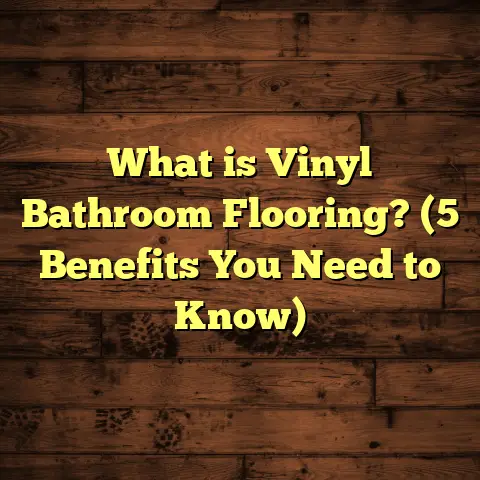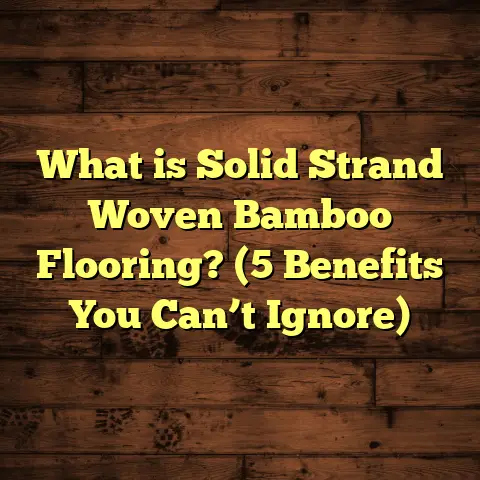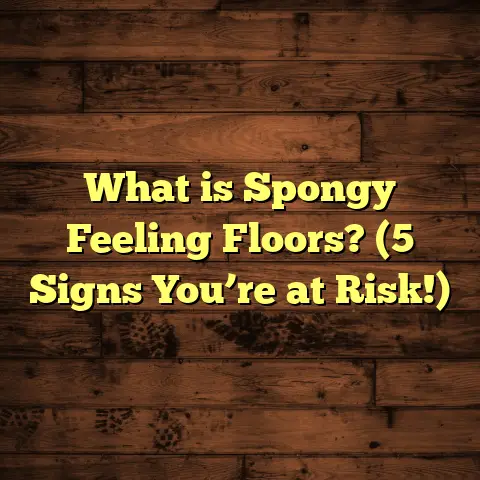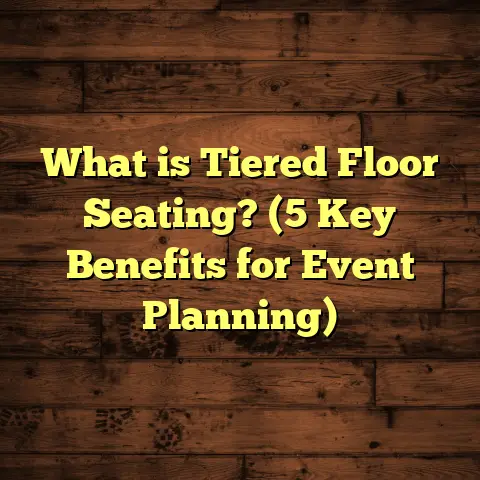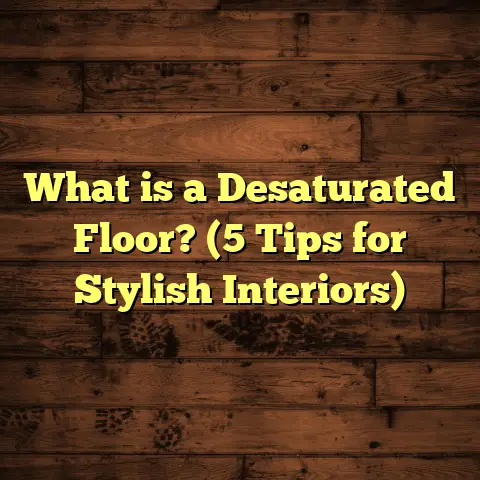What is Vapor Barrier Flooring? (5 Tips You Must Know!)
Seasonal changes always remind me how much moisture can affect a home, especially the floors. When winter’s chill hits and snow melts, or when spring showers soak the ground, that moisture doesn’t just disappear — it sneaks into places you might not expect. This is exactly why vapor barriers in flooring have become a hot topic in my work and conversations with homeowners. Have you ever wondered why your basement floor feels damp or why your hardwood starts warping after a rainy season? Let’s chat about vapor barrier flooring—what it is, why it matters, and five tips I’ve learned over the years that you should know.
What Is Vapor Barrier Flooring?
Simply put, vapor barrier flooring involves installing a material that blocks moisture from passing through floors—particularly concrete slabs or subfloors—into your living space. Think of it as a shield that stops water vapor traveling upward from the ground or through humid environments. This barrier prevents moisture-related problems like mold growth, warping, and deterioration of your flooring materials.
When I first started working in flooring, I saw so many cases where homes had no vapor barriers, leading to warped hardwood or soggy carpets. It’s crazy how invisible water vapor can cause such damage over time. A proper vapor barrier is usually a plastic or foil sheet placed underneath the floor covering or between the subfloor and the finished floor.
Most commonly used in basements and ground-level floors, vapor barriers play a huge role in protecting flooring materials and maintaining indoor air quality. Without it, moisture gets trapped under your floors, creating an ideal environment for mildew and compromising the structural integrity of your floors.
Why Does Moisture Matter So Much?
Moisture can come from the soil directly beneath your home or from humidity in the air. According to the U.S. Department of Energy, moisture intrusion is responsible for about 40% of all building failures. That’s a huge number! When moisture penetrates flooring materials like wood or laminate, it causes swelling, buckling, and can even lead to serious health hazards like mold spores.
In one project I worked on, a homeowner complained about a musty smell and soft spots on their laminate floor in the basement. After inspection, we found no vapor barrier had been installed under the floor covering. Once we added a high-quality polyethylene vapor barrier during replacement, the issue disappeared within weeks.
Common Types of Vapor Barriers
- Polyethylene Sheets: The most common type, these come in various thicknesses (typically 6 to 20 mils). Thicker sheets provide better protection but cost more.
- Foil-Backed Barriers: These offer added reflectivity and help with thermal insulation.
- Liquid Membranes: Applied directly onto concrete slabs, they form a continuous waterproof layer.
- Specialty Underlayments: Some underlayments designed for laminate or engineered wood floors include integrated vapor barriers.
Each type suits different situations depending on the flooring material, subfloor condition, and moisture levels.
Why I Became Passionate About Vapor Barriers
Let me share a bit about how I came to appreciate vapor barriers so much in my work. Early in my flooring career, I was part of a crew installing hardwood floors in a charming older home with a concrete slab basement. We did everything “by the book” except we skipped installing a vapor barrier beneath the hardwood because the slab seemed dry at first glance.
Within three months after installation, the homeowner called me frantic—the beautiful hardwood had started cupping and warping badly. The smell of dampness was noticeable too. I learned firsthand how even slight amounts of moisture coming through concrete can wreak havoc on wood floors.
We had to rip out the floor, dry the slab for weeks using industrial fans and dehumidifiers, then install a thick polyethylene vapor barrier before reinstalling new hardwood planks. The difference was night and day—no more warping or odors after that.
That experience shaped how I approach every project now—never underestimate moisture or skip testing before installation.
How Moisture Moves Through Floors: The Science Behind Vapor Barriers
Understanding how moisture moves is key to grasping why vapor barriers are so vital. Moisture travels through concrete slabs by diffusion—a process where water molecules move from an area of higher concentration (wet soil beneath your foundation) to lower concentration (dry indoor air).
Concrete is porous; even if it looks dry on the surface, water vapor can seep slowly through microscopic channels. Over time, this vapor accumulates under your flooring materials.
Here’s a statistic I find eye-opening: According to research from the Portland Cement Association, water vapor transmission rates through concrete slabs range from 0.1 to 0.5 pounds per 1,000 square feet per hour depending on slab density and moisture content.
Without a vapor barrier, that slow but steady movement of moisture leads to problems like:
- Wood Floor Cupping: Wood planks absorb moisture from below causing edges to rise.
- Mold Growth: Trapped moisture creates mold-friendly environments.
- Adhesive Failure: Glue used in floor installations loses effectiveness when wet.
- Flooring Deterioration: Materials like laminate swell or delaminate.
So the vapor barrier acts like a dam—blocking this invisible flow of moisture before it reaches your finished floor.
Common Flooring Problems Vapor Barriers Prevent
From my experience working with homeowners and contractors alike, here are some common issues that vapor barriers help prevent:
Warping and Buckling
Wood expands when wet. Without a barrier stopping moisture migration from below, wood floors absorb this water vapor causing them to swell unevenly. This leads to cupping or buckling that can ruin a floor’s look and function.
Mold and Mildew
Mold thrives in damp environments hidden beneath floors. This not only damages materials but poses health risks for occupants. In homes where indoor air quality matters—especially for allergy sufferers—a vapor barrier is a must-have.
Peeling Adhesives
For glued-down floors like vinyl or engineered hardwood, moisture can weaken adhesives causing tiles or planks to lift prematurely.
Subfloor Damage
Moisture trapped between subfloor layers leads to rot and structural weakening over time—something that can go unnoticed until serious repairs are needed.
More Than Just Protection: Vapor Barriers Improve Indoor Comfort
It might surprise you that vapor barriers also contribute indirectly to indoor comfort and energy efficiency. By keeping floors dry, they prevent cold spots caused by dampness which draws heat away.
Homes with proper vapor barriers tend to feel warmer during cold months and more consistent in temperature year-round because there’s less moisture-related heat loss through floors.
I worked on one home where simply adding a vapor barrier under carpeted basement floors led to noticeable warmth improvement—no extra insulation needed! It was such an easy upgrade but made a big difference in comfort.
How To Know If You Need A Vapor Barrier
Not every flooring job requires one but many do. Here are some quick ways to assess if you need it:
- Is your floor installed over concrete slabs or ground-level subfloors?
- Does your area have high humidity or frequent rain?
- Are you installing wood or laminate sensitive to moisture?
- Have you noticed musty smells or dampness on basement floors?
- Did you test moisture levels above recommended limits?
If you answered yes to any of these questions, installing a vapor barrier is highly recommended.
Detailed Tip #1: Testing Moisture Levels Before Installation
I can’t stress this enough: testing moisture levels is step one before laying down any floor covering.
There are two main testing methods:
Calcium Chloride Test
This measures moisture emission rate from concrete slabs over 24 hours. The industry standard limit for wood floors is typically ≤3 lbs/1000 sq ft/24 hours.
Relative Humidity Test
Involves drilling holes into slabs and measuring humidity inside concrete with sensors. Limits vary by material but generally below 75% RH is acceptable for hardwood.
Both tests provide objective data rather than guessing based on surface dryness.
Detailed Tip #2: Selecting The Right Vapor Barrier Material And Thickness
Material choice depends on project specifics but polyethylene sheeting remains most popular due to affordability and effectiveness.
Thickness is measured in mils (thousandths of an inch):
- 6 mil is minimum code requirement
- 10-15 mil preferred for durability
- 20 mil used in extreme cases or commercial projects
I usually recommend thicker sheets because they resist punctures better during installation and last longer without degradation.
Detailed Tip #3: Proper Installation Techniques To Maximize Effectiveness
Installing the barrier properly is just as important as choosing the right type:
- Lay sheets flat with overlaps of at least 6 inches
- Use specialized vapor barrier tape on all seams
- Extend barrier up walls slightly (called “upturn”) before sealing
- Avoid puncturing with nails or staples; use adhesive instead
- Cover entire floor area including beneath cabinets or fixed furniture zones
Detailed Tip #4: Handling Penetrations And Transitions
Small details matter! Pipes, wires, vents passing through floors create weak spots where moisture can sneak past barriers if not sealed correctly.
I always wrap pipes with extra sheets and use flexible sealants designed for vapor barriers around edges. For transitions between rooms or stairs, taping and overlapping ensure continuity.
Detailed Tip #5: Combining Vapor Barriers With Insulation And Drainage Solutions
In cold climates especially, pairing vapor barriers with insulation reduces condensation risk caused by temperature differences between inside air and cold slabs.
Also consider site drainage improvements outside your home to reduce water pooling near foundations that could increase slab moisture levels.
Case Study: Basement Remodel Saving Thousands With Proper Vapor Barrier Installation
A few years ago I worked with a family remodeling their damp basement into living space. The old concrete slab had no vapor barrier and high moisture readings (6%+).
We installed thick 15 mil polyethylene sheets taped at seams plus rigid foam insulation panels above with sealed joints. The finished engineered hardwood floor showed zero signs of warping after a full year—even during rainy seasons.
The family told me they avoided costly repairs others nearby faced because they took moisture seriously upfront.
More Data On Vapor Barriers From Industry Research
The National Wood Flooring Association (NWFA) recommends using vapor barriers on all concrete slab installations where moisture emission exceeds 3 lbs/1000 sq ft/day.
Studies show homes with effective vapor barriers reduce flooring failure rates by up to 70%, saving thousands in repairs over decades.
How FloorTally Helps Me Plan Costs For Vapor Barrier Flooring Jobs
Estimating overall project budgets accurately is critical when adding vapor barriers because you have material costs plus labor time for installation and sealing.
Personally, I use FloorTally to help me estimate costs based on local prices for polyethylene sheets, tapes, labor rates, waste factor percentages (usually around 5-10%) plus associated flooring material cost.
It’s super handy because it consolidates everything into clear numbers quickly so I can give clients realistic budgets without guesswork or surprises later on.
Comparing Vapor Barrier Flooring To Other Moisture Control Methods
You might be wondering if other options could replace vapor barriers:
| Solution | Pros | Cons | When To Use |
|---|---|---|---|
| Vapor Barrier Sheets | Affordable, easy install; blocks vapor | Can be punctured; needs careful sealing | Most residential slab floors |
| Liquid Membranes | Seamless waterproofing | Requires curing; professional install | High-moisture commercial areas |
| Waterproof Membranes | Handles liquid water | More expensive; sometimes overkill | Wet rooms like bathrooms |
| Moisture-Resistant Floors | Better tolerance | Doesn’t stop ground moisture | Basements with vinyl/tile |
| Dehumidifiers/Ventilation | Controls humidity | Doesn’t block ground moisture | Supplemental solution |
For typical homes with wood or laminate floors over slabs, vapor barriers remain my go-to solution because they tackle root cause—moisture migrating from soil up through concrete.
Personal Reflections On Challenges And Successes With Vapor Barrier Flooring
Over nearly two decades in flooring work, I’ve seen everything from botched installations causing costly callbacks to perfectly executed projects lasting decades without issues.
One challenge remains educating homeowners about why something invisible like water vapor needs attention before they see damage—selling the idea isn’t always easy!
But when I explain how simple additions like vapor barriers save thousands long-term plus improve comfort and health—it usually clicks.
My most satisfying jobs are those where clients call me back years later saying their floors still look great thanks to upfront prevention measures including proper vapor barriers.
Final Thoughts On Protecting Your Floors From Moisture
Moisture is one of those hidden enemies that can quietly ruin your floors over time if left unchecked. From my hands-on experience, installing an effective vapor barrier is one of the smartest moves you can make to protect your investment and your home’s health.
By testing moisture levels first, choosing the right thickness barrier, sealing seams carefully, addressing penetrations properly, and pairing with insulation when needed—you create a strong defense against dampness creeping up through your floors.
If you’re weighing options between vapor barriers and other waterproofing methods, remember each has its place based on needs and budget—but vapor barriers remain an essential line of defense for everyday residential flooring projects.
So next time you notice dampness underfoot or plan new floors over concrete slabs or basements, ask yourself: Is my floor protected from unseen moisture? Taking action on this simple question will save you from costly repairs down the line—and that’s advice from someone who’s seen it all firsthand.
If you want me to add specific sections like DIY installation steps or regional considerations next, just ask!

